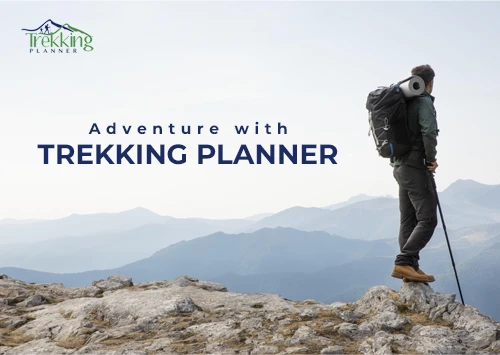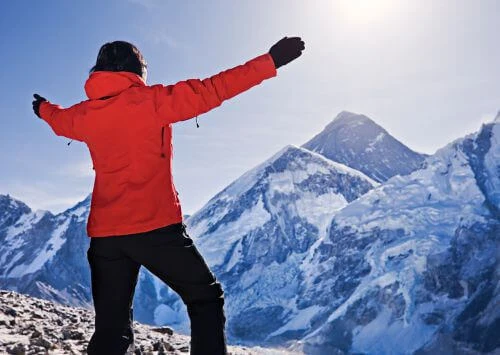Packing for Trekking in Nepal.
Packing your things, clothing and equipments among the other things, are one of the most essential things to complete your trekking in Nepal. Remember that you have to pack light and smart for a comfortable trekking experience in Nepal. Use this list below to pack your things. Use it as a guideline for your packing. Exact list depends on the trekking destination and other factors related to you, the trekker.
We have compiled the following list of things you need to pack considering keeping in mind the peak season of trekking in Nepal. Trekking in other seasons may require you to make adjustments in this list. Consult with your trekking company for the precise list.
Climbing Equipment
- Ski poles: A pair, for balance and support
- Multi- Led headlamp: One piece, powerful lumen measures for hands free illumination in mountain region.
- Crampons: one pair, helps to improve mobility on snow and ice
- Locking and non-locking Carabiners: 6-8, helps in attaching things to your harness
- Climbing Harness: one piece, padded waist belt with leg loops, connected front and back. Helps to secure a rope during climbing
- Prusik Cords: One pair, Used for backup safety and ascending
- Rappel/ Belay device: one piece per climber, helps to control the rope during the descent from a cliff
- Lightweight pulleys: set of at least two or four, pulley which helps to reduce rotational mass
- Avalanche Transceiver: one piece per individual, used for avalanche safety
- Ice Axe: one piece per climber, used for ice climbing
- Ascender: one piece per climber, used for ascending ropes
- Climbing Helmet: one piece per climber, used for head safety
- Ropes: used in pairs. While one is used as main rope and other a backup.
- Slings: Used in sets of four or more. Helps to create anchorage and provide protection.
Upper Body Cloths
Breathable and Waterproof jacket with a large hood that can fit the helmet: One jacket is sufficient to provide warmth.
Lightweight Marino long sleeve t-shirt: Used as base layer.
Lightweight down jacket: Used as insulation.
Lightweight Marino t-shirt: Used as base layer
Medium weight fleece pullover: Used in insulation
Warm down/ duvet suit: Used as all in one insulated suit
Lightweight thermal base layers: Includes Upper and lower portion so one set is sufficient.
Fleece jacket: Provides insulation
Lower Body Cloths
Lightweight thermal bottoms: Used as Base Layers, one set is sufficient
Waterproof and breathable trousers with full side zips: Protection against wind and water.
Fleece trouser: Individual use for insulation
Warm down/ duvet bibs: Protect against cold temperatures by providing insulation.
Walking trouser: Durable and moisture wicking which provides ease while ascent.
Walking shorts: Base layer which offers breathability and flexibility.
Heavy thermal bottoms: Provide warmth during extreme cold.
Lightweight underwear briefs: Helps to maintain hygiene and comfort during mountain climb.
Hand wear
Medium weight gloves: One pair, select suitable piece which provides insulation and flexibility.
Warm fleece mitt liner paired with over mitt: Warm fleece mitt is worn as base layer that provides insulation and comfort while overmitt is worn on top. Select durable and waterproof overmitt to protect against wind, moisture and extreme conditions.
Lightweight poly-liner gloves: Used as base layers under other gloves which help to keep your hands dry.
Headwear
- Face mask: Used to cover nose and mouth for protection against cold temperature.Synthetic or warm wool hat: Used to cover head and ears in cold weather.
- Scarf, buff, or neck sleeve: Helps to protect neck and face against cold, wind and snow.
- Head Scarf or Bandana: Helps to protect your head and hair from sweat and sun and provide warmth in cold.
- Ski goggles (light or dark lens optional): Protects your eyes from wind, snow, and glare.
- Balaclava: It is a full face covering cloth which covers head, face and neck leaving only eyes exposed.
- Eyes and nose coverage eyewear: Helps to protect eyes and nose from wind, snow and cold.
- Sun cap/ hat: Help to protect against UV rays in high altitude.
- Glacier sunglass: Helps to protect eyes from intense sunlight, glare and UV rays.
Footwear
- Lightweight wool or cotton socks: Provides foot comfort and help to manage moisture. Wear at lower altitude.
- Sturdy synthetic or leather hiking boots with good ankle: Helps to provide good ankle support and stability.
- Lightweight trekking socks: Used in mild conditions during ascent or descent phase of climb.
- Down boot (optional): Helps to provide extra insulation and warmth.
- Medium or heavy wool or poly socks: Provide extra insulation and help retain warmth.
- Poly or wool Liner socks: Used as base layer beneath the regular socks. Helps to reduce moisture, friction and minimize the chances of blisters.
- Overboot or good quality plastic shell Aveolite liners with inner boot: Adds additional layer of protection and insulation.
- Cross trainers or running shoes: Generally not recommended. However can be used in the beginning of the journey. Usually used in road trips and flat surface walking.
Travel Bags
- Large waterproof duffle kit bag (7500 cubic inch/ 120 L): Can hold up to 25kgs per person
- Additional sleeping bag for base camp (rated to handle -20 / -30): Essential for goodnight sleep at base camp or teahouse in mountain region. Provides warmth and comfort at extreme cold weather.
- Medium rucksack (3000-4500 cubic inches/50-70 liters): Essential in carrying items during climb. Provide easy mobility and convenience.
Sleeping Gear
- Closed-cell foam mat for base camp and high altitude: Helps to provide cushioning in cold ground. Provides comfort and warmth.
- Small and protective padlocks: For safety of your gears and belongings.
- Down sleeping bag for high altitude (rated to handle -35 / -30): Provides higher warmth and insulation.
- Pack cover: Helps to protect your backpack from rain and moisture.
Personal Hygiene
- Synthetic towel: Quick drying and lightweight
- Bar soap: Protect against bacterial infection.
- Toothbrush/paste set: For oral hygiene.
- Wet wipes and toilet paper: In order to cope against Traditional restroom facilities.
- Hand sanitizer: Kills germs and Bacteria.
- High SPF sunscreen: Protection against UV rays.
- Moisturizer: Helps to keep the skin hydrated.
- Body lotion: To prevent dry, cracked and wrinkled skin.
- Anti-mosquito cream: Protect against mosquito and insect bites.
First-aid Kit
- Skin blister repair kit: To treat blisters and prevent infection
- Small bottle anti-headache pills: Provides relief against altitude sickness, dehydration or stress.
- Water treatment tablets: Helps to purify water and protect from waterborne illness. (1 tablet aqua tab consists of 50 pills, one pill can be used to purify 1 liter of water). The purification process takes about 15 minutes.
- Personal medication with prescription: Any individual with specific medical condition may require prescribed medicine. Be sure to bring those to prepare fo any sort of emergencies.
- Small personal kit including aspirin, Band-Aids, tape, personal medication, etc.
- Small bottle anti-diarrhea pills: To prevent against diarrhea.
- Water filters: An alternative to Water treatment tablets.
- Antibiotics for chest or stomach: Used for respiratory or gastrointestinal issues.
- Small bottle cough medicine: Helps to provide relief against cough.
Personal Food: Personal food can be used as emergency reserves while climbing. During the Hike, teahouses can be afar so bringing food helps to get quick snack energy and continue the walk.
- Nuts such as cashews and almonds: Source of fats, protein and energy.
- Caffeinated gel packets: Rapid source of Energy
- Dried fruits: Provide natural sugar.
- Tortilla wraps: Used as on the go meals by adding cheese, meat or vegetables.
- Honey and Banana: Great source of energy, sugar and potassium.
- Synergy and granola bars: Source of carbohydrate and protein.
- Chocolate Bars: Provides energy.
- String cheese: Source of protein.
Miscellaneous Items
- Alarm clock/watch
- Sewing kit
- Plastic cup and spoon
- Digital camera with extra batteries and SD card
- Water bottle
- Large waterproof disposable garbage bags
- Nylon sacks for food and gear storage
- Binoculars
- Earplugs
- Folding knife
- Compass or GPS
- Cash for personal use
- Credit or debit cards to withdraw money from machines
- iPod/MP3 player, Gameboy, books, travel games, short-wave radio, etc
- Small roll of repair tape
Travel Document
- Separate copies of passport and relevant visa pages: This can help in case of loss of original documents. May also be used in various administrative purposes during the trip.
- Passport: Most important travel document. Passport is your primary means of identification. It is required in check posts, permit points and sometimes checking in at hotels.
- Proof of insurance: Helps to provide coverage in unforeseen circumstances.
- Extra passport size photos: Used in permits and local identification cards.
- Flight ticket and tour itinerary: Helps in boarding flights and showing proof of travel plans. Also helps you to stay organized and understand the day plan.
We hope that this list proves very helpful for your packing to various interesting and adventurous destinations in Nepal. Consult with us or your trekking company for precise list and have discussion with other trekkers, if you know or if you can contact them, who have returned recently from the destination you plan to go. Pack smart and trek well. Have happy trekking fellow trekkers!





